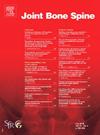Improvement of rhizarthrosis pain management with the infiltration of hyaluronic acid and corticosteroids versus corticosteroids alone
IF 3.8
3区 医学
Q1 RHEUMATOLOGY
引用次数: 0
Abstract
Objectives
The clinical management of rhizarthrosis relies on several pharmacological approaches, demonstrating variable efficacy. The present study aimed at assessing the potential benefit of the combined infiltration of corticosteroids and hyaluronic acid to reduce trapeziometacarpal osteoarthrisis pain at three months, as compared to the administration of corticosteroids alone.
Methods
We conducted a single-blind trial with two parallel groups and blinded evaluation. Eligible patients (n = 150) were randomly assigned to receive hyaluronic acid and corticosteroid (n = 74) or saline and corticosteroid infiltrations (n = 76. Pain was evaluated one, three, six or twelve months (M1, M3, M6, M12) after infiltration.
Results
In total, 149 patients received the injection (mean age 62 years old; 83% females). When looking at the primary end point (M3), reduction of pain during activity was greater in the hyaluronic acid + corticosteroid group, as compared to the corticosteroids + placebo (difference −1.1 on a 0–10 points visual analogue scale, 95% confidence interval [−1.9; −0.2], P = 0.012). For the secondary end points (visual analogue scores at rest and during activity at M1, M6 and M12), improvements were observed, although not statistically significant (except at M1). Finally, grip and opposition strength remained unchanged between groups along the follow-up.
Conclusions
In patients with painful rhizarthrosis, the infiltrations of hyaluronic acid and corticosteroids demonstrate better efficacy in reducing pain during activity 3 months after intervention, compared to injections with only corticosteroids. The present study brings new arguments in favour of the combination of these two drugs for the clinical management of trapeziometacarpal osteoarthrisis.
透明质酸和皮质类固醇与单独皮质类固醇浸润对根椎病疼痛管理的改善。
目的:根腐病的临床治疗依赖于几种药理学方法,表现出不同的疗效。本研究旨在评估皮质类固醇和透明质酸联合浸润与单独使用皮质类固醇相比,在三个月时减轻斜跖骨关节炎疼痛的潜在益处。方法:采用双平行组进行单盲试验和盲法评价。符合条件的患者(n=150)被随机分配接受透明质酸和皮质类固醇(n=74)或生理盐水和皮质类固醇浸润(n=76),在浸润后1、3、6或12个月(M1、M3、M6、M12)评估疼痛。结果:共有149例患者接受了注射,平均年龄62岁;83%的女性)。当观察主要终点(M3)时,与皮质类固醇+安慰剂组相比,透明质酸+皮质类固醇组在活动期间疼痛的减轻更大(0-10分视觉模拟量表差异-1.1,95%置信区间[-1.9;-0.2, p = 0.012)。对于次要终点(M1、M6和M12休息和活动时的视觉模拟评分),观察到改善,尽管没有统计学意义(M1除外)。最后,在随访过程中,各组之间的握力和反对力量保持不变。结论:在疼痛性根椎病患者中,透明质酸和皮质激素的浸润在干预后3个月的活动期间减轻疼痛的效果优于仅注射皮质激素。目前的研究提出了新的论点,支持这两种药物联合用于临床治疗斜跖骨关节炎。
本文章由计算机程序翻译,如有差异,请以英文原文为准。
求助全文
约1分钟内获得全文
求助全文
来源期刊

Joint Bone Spine
医学-风湿病学
CiteScore
4.50
自引率
11.90%
发文量
184
审稿时长
25 days
期刊介绍:
Bimonthly e-only international journal, Joint Bone Spine publishes in English original research articles and all the latest advances that deal with disorders affecting the joints, bones, and spine and, more generally, the entire field of rheumatology.
All submitted manuscripts to the journal are subjected to rigorous peer review by international experts: under no circumstances does the journal guarantee publication before the editorial board makes its final decision. (Surgical techniques and work focusing specifically on orthopedic surgery are not within the scope of the journal.)Joint Bone Spine is indexed in the main international databases and is accessible worldwide through the ScienceDirect and ClinicalKey platforms.
 求助内容:
求助内容: 应助结果提醒方式:
应助结果提醒方式:


